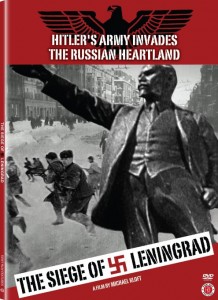The film provides a brief description of the city and its
people at the time before the siege began. The narrator tells us: “In
Leningrad it was considered inappropriate to be concerned about international
events and lend credence to unhealthy moods, as they were called.” In
addition to interviews with citizens of Leningrad, the film includes an interview
with Anna Reid, author of Leningrad: Tragedy Of A City Under Siege, who
talks about how the new soldiers were given very little training and few
weapons. And there is footage of citizens volunteering for military service.
But it is the footage of the citizens trying to survive
within the city that is most striking, such as the shots of people desperately
collecting water. On September 8, 1941, the last remaining land connection
between Leningrad and the rest of the country was cut off. The Nazis bombed
food storage facilities and warehouses and factories in the early days, and
food reserves became scarce within a few weeks. There is a lot of specific
information on the rationing of food, such as the fact that people with jobs
got twice the amount of bread as those without jobs.
While battling hunger, the inhabitants also had to deal
with the terrible cold of winter. And there is some interesting and depressing
information on the changing behavior of citizens, as dead bodies on the streets
became a common sight. The zoo animals and pets were killed for food, and some
people even resorted to cannibalism. (There is one story of a mother who fed
pieces of her dead son to her daughter to keep her alive.) Between January and
March of 1942, approximately 300,000 people died in Leningrad. While the siege
lasted until early 1944, the film focuses on 1941 and 1942.
One detail I found interesting is that immediately after
the war, a large museum was opened to chronicle the siege, and that then in
1948 Stalin had it destroyed “out of fear of its power to unify the people,”
according to the narrator. Decades later, a smaller museum opened, and the film
includes an interview with museum curator Irina Muravjova. There is a lot of
information from the diaries from the time.
One complaint I have regarding this film is that instead
of including English subtitles for those interviewed, a translator provides
voice over. The problem is the sound in the original language is not lowered,
so it’s sometimes difficult to concentrate, because you’re hearing two voices
speaking simultaneously at the same volume.
The Siege Of Leningrad was written and directed by
Michael Kloft, and was released on DVD on August 26, 2014 through First Run
Features. Also released on that date was Kloft’s “Fuhrer” Cult And Megalomania.





No comments:
Post a Comment